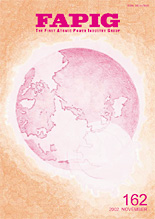![]()
FAPIG
THE FlRST ATOMlC POWER INDUSTRY GROUP
FAPIG誌 最新号目次
2002−11/平成14年度 第2号(No.162)

|
目 次 ■ 報 告 ■ 紹 介 ■ グループ情報 ● Fresh Information(川崎重工) (17) 表紙デザイン:酒井美菜子 CONTENTS ■ Report ■ Introduction ■ FAPIG Activities ● Fresh Information (KAWASAKI HEAVY INDUSTRIES) (17) Cover Design:Minako Sakai
SYNOPSES Hidehito Koike, Masaaki Sobajima, Minoru Yokoyama, Fumihiko Oda, Masayuki
Kawai, Haruo Kuroda, Kouji Nakai, The FIR-FEL project group, collaboration of Tokyo University of Science and Kawasaki Heavy Industry, Ltd. (KHI), has completed the design of an S-band linac based FIR-FEL device at a spectral range between 300 and 1000 micrometers in 2000. And the FEL device has already been installed in the IR FEL Center at Tokyo University of Science in April 2002. Our optical resonator is composed of a waveguide with a gap of 4.5 mm and two cylindrical mirrors positioned among the waveguide surfaces in order to improve a slippage problem and diffraction losses. The waveguide makes a slippage length reduce and makes a lasing at the spectral range easier. In this paper, the design and the fabrication of the FIR-FEL device, RF components, linac, optical resonator, and beam transport line are described. KEYWORDS:FEL, far-infrared, rf-gun, bunching, slippage Kei Aoyama, Katumi Yasutomo, Takayuki Sudou, Masahiro Yamashita, Kenichi
Hayata, Hajime Ueda, Hideo Hosokawa Radiation management of nuclear power research institutes, nuclear
power stations and other such facilities are strictly managed under
Japanese laws and management policies. KEYWORDS:Radiation management computer system, World wide web, Access control system, Radiation monitor Ichiro Kawaguchi, Takeshi Matsumoto, Motohiko Nishimura, Seiichiro
Yamazaki, Katsutoshi Kugai, Minoru Yokosawa, Various low-level radioactive solid wastes are stored on sites of nuclear power plants and research laboratories. The volume of these wastes should be reduced before disposal. The high-frequency induction melting system is preferable when the amount of waste is not large and the operation ratio of the facility is not high. A new high-frequency induction melting system using a ceramic canister and a heat loss compensator (Active Insulator) was developed. The full-scale system was installed and the melting performance tests were conducted. Carbon steel and stainless steel were used as the simulated metallic wastes. Thermal insulators and HEPA filters were main simulants for inorganic wastes. The sleeve shape active insulator helped the volumetric heat of the metal layer transfer to the slag layer. KEYWORDS:solid waste, melting, volume reduction, high-frequency induction, canister, heat loss compensator, active insulator Shuichi Tanahashi, Hiroshi Kawamura We have developed a system to distribute incident solar radiation products obtained using Geostationary Meteorological Satellite (GMS) data in near real time. GMS data is received every hour, and high-spatial resolution images of incident solar radiation are produced. The hourly solar radiation is obtained for 0.01-degree grids, which will be meet requirements of the solar energy projects in the world. The estimated daily values are validated by ground measurements, which show a root-mean square error of about 8〜14%. Several products of solar radiation are produced immediately after the hourly GMS data reception and are then transferred to the web server for on-line access from the users. The system has been continuously operated since June 1997. KEYWORDS:solar energy project, incident solar radiation, high spatial resolution, geostationary meteorological satellite, GMS, ground measurement, web server, system |
バックナンバー目次
|
号数 |
発行年月 |
| 161 | 2002/ 7 |
| 160 | 2002/ 3 |
| 159 | 2001/11 |
| 158 | 2001/ 7 |
| 157 | 2001/ 3 |
| 156 | 2000/11 |
| 155 | 2000/ 8 |
| 154 |
2000/
3
|
| 153 |
1999/11
|
| 152 |
1999/ 7
|